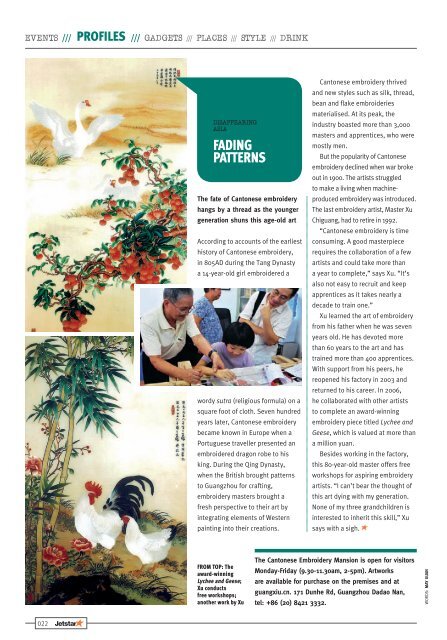Create successful ePaper yourself
Turn your PDF publications into a flip-book with our unique Google optimized e-Paper software.
EVENTS /// PROFILES /// GADGETS /// PLACES /// STYLE /// DRINK<br />
022<br />
DISAPPEARING<br />
ASIA<br />
FADING<br />
PATTERNS<br />
The fate of Cantonese embroidery<br />
hangs by a thread as the younger<br />
generation shuns this age-old art<br />
According to accounts of the earliest<br />
history of Cantonese embroidery,<br />
in 805AD during the Tang Dynasty<br />
a 14-year-old girl embroidered a<br />
wordy sutra (religious formula) on a<br />
square foot of cloth. Seven hundred<br />
years later, Cantonese embroidery<br />
became known in Europe when a<br />
Portuguese traveller presented an<br />
embroidered dragon robe to his<br />
king. During the Qing Dynasty,<br />
when the British brought patterns<br />
to Guangzhou for crafting,<br />
embroidery masters brought a<br />
fresh perspective to their art by<br />
integrating elements of Western<br />
painting into their creations.<br />
Cantonese embroidery thrived<br />
and new styles such as silk, thread,<br />
bean and fl ake embroideries<br />
materialised. At its peak, the<br />
industry boasted more than 3,000<br />
masters and apprentices, who were<br />
mostly men.<br />
But the popularity of Cantonese<br />
embroidery declined when war broke<br />
out in 1900. The artists struggled<br />
to make a living when machineproduced<br />
embroidery was introduced.<br />
The last embroidery artist, Master Xu<br />
Chiguang, had to retire in 1992.<br />
“Cantonese embroidery is time<br />
consuming. A good masterpiece<br />
requires the collaboration of a few<br />
artists and could take more than<br />
a year to complete,” says Xu. “It’s<br />
also not easy to recruit and keep<br />
apprentices as it takes nearly a<br />
decade to train one.”<br />
Xu learned the art of embroidery<br />
from his father when he was seven<br />
years old. He has devoted more<br />
than 60 years to the art and has<br />
trained more than 400 apprentices.<br />
With support from his peers, he<br />
reopened his factory in 2003 and<br />
returned to his career. In 2006,<br />
he collaborated with other artists<br />
to complete an award-winning<br />
embroidery piece titled Lychee and<br />
Geese, which is valued at more than<br />
a million yuan.<br />
Besides working in the factory,<br />
this 80-year-old master offers free<br />
workshops for aspiring embroidery<br />
artists. “I can’t bear the thought of<br />
this art dying with my generation.<br />
None of my three grandchildren is<br />
interested to inherit this skill,” Xu<br />
says with a sigh.<br />
The Cantonese Embroidery Mansion is open for visitors<br />
FROM TOP: The<br />
award-winning<br />
Monday-Friday (9.30-11.30am, 2-5pm). Artworks<br />
GUAN<br />
Lychee and Geese; are available for purchase on the premises and at<br />
Xu conducts<br />
MAY<br />
free workshops;<br />
guangxiu.cn. 171 Dunhe Rd, Guangzhou Dadao Nan,<br />
another work by Xu tel: +86 (20) 8421 3332.<br />
WORDS:
















